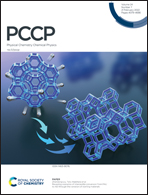Molecular-level electrocatalytic CO2 reduction reaction mediated by single platinum atoms†
Abstract
The activation and transformation of H2O and CO2 mediated by electrons and single Pt atoms is demonstrated at the molecular level. The reaction mechanism is revealed by the synergy of mass spectrometry, photoelectron spectroscopy, and quantum chemical calculations. Specifically, a Pt atom captures an electron and activates H2O to form a H–Pt–OH− complex. This complex reacts with CO2via two different pathways to form formate, where CO2 is hydrogenated, or to form bicarbonate, where CO2 is carbonated. The overall formula of this reaction is identical to a typical electrochemical CO2 reduction reaction on a Pt electrode. Since the reactants are electrons and isolated, single atoms and molecules, we term this reaction a molecular-level electrochemical CO2 reduction reaction. Mechanistic analysis reveals that the negative charge distribution on the Pt–H and the –OH moieties in H–Pt–OH− is critical for the hydrogenation and carbonation of CO2. The realization of the molecular-level CO2 reduction reaction provides insights into the design of novel catalysts for the electrochemical conversion of CO2.

- This article is part of the themed collection: 2022 PCCP HOT Articles


 Please wait while we load your content...
Please wait while we load your content...